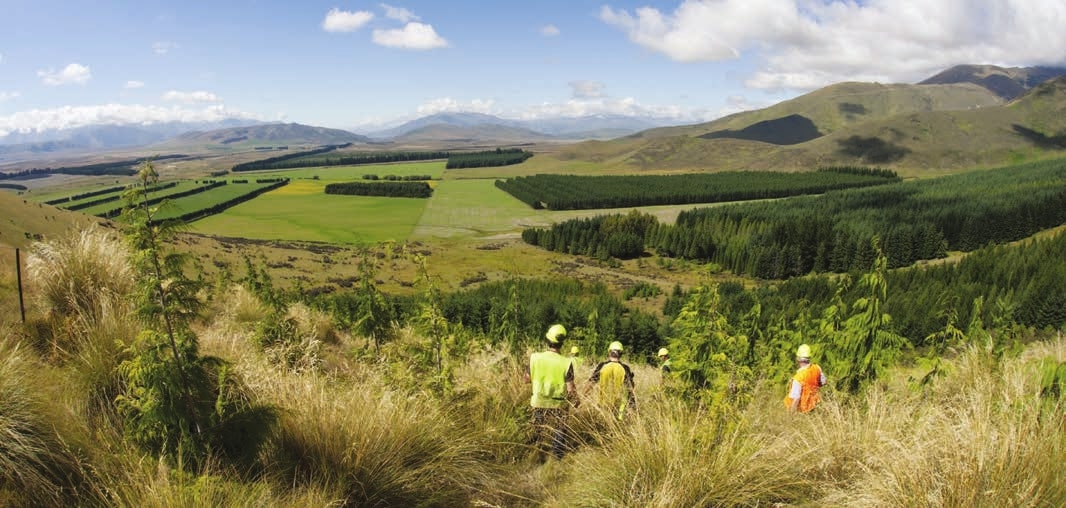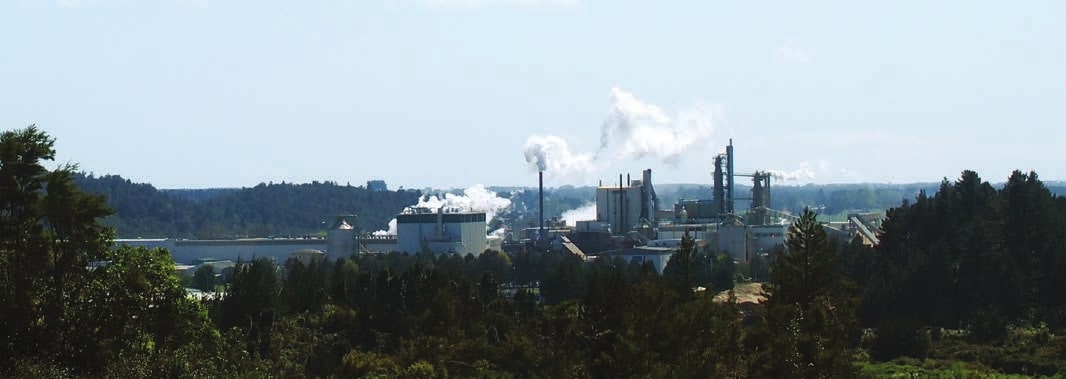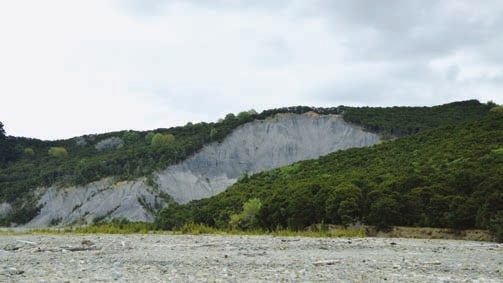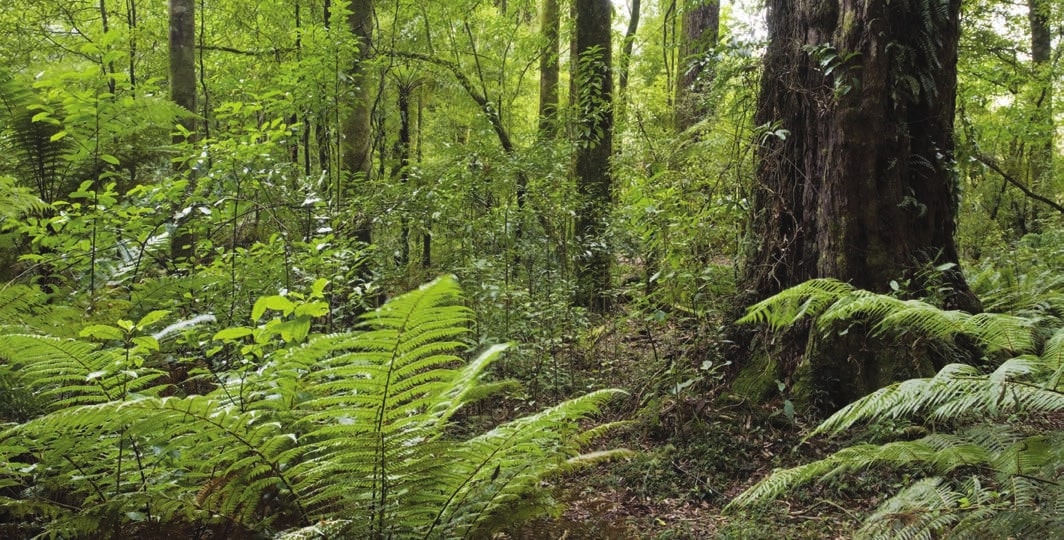One billion trees - multiple opportunities: Planted forests are essential for future New Zealand
Michelle Harnett and Tim Payn, New Zealand Tree Grower November 2018.
The words ‘anything but pine trees’ pop up on social media every time the government’s billion trees programme is mentioned. Planted forests in New Zealand may have a public relations problem but the plan to plant more and varied trees opens up opportunities for forestry, the environment and the people of New Zealand.
Large forests are essential for the future environmental and economic wellbeing of New Zealand. The report released by the Intergovernmental Panel on Climate Change in October emphasised that the Earth warming 1.5°C would have grim consequences for the planet and that global greenhouse gas emissions needed to be slashed, and soon. New Zealand has domestic and international targets to reduce its greenhouse gas emissions. The most challenging is the current government’s aim to achieve a nett carbon zero economy by 2050.
Trees and other plants effectively and efficiently remove carbon dioxide from the air. The recent report from the New Zealand Productivity Commission clearly identified that the most important source of domestic emissions mitigation in New Zealand is afforestation. The Productivity Commission predicts that planting an extra one to three billion trees, mostly on marginally profitable beef and sheep land, will be needed over the next 30 years to move New Zealand to a low emissions economy.
Forestry and forestry waste have been identified as New Zealand’s largest source of sustainable and renewable biomass for biofuels to replace liquid fuels, especially in the heavy transport, aviation and marine sectors. A recent Scion report outlining options for a bio-fuelled New Zealand identified that an extra quarter of a billion hectares of forest would be needed to provide 30 per cent of the country’s liquid fuel needs by 2050. Beyond biofuels, forests and forestry by-products are also likely sources of other bio-based chemicals and bioplastics with the potential to replace petroleum-based products and further reduce emissions.
Using sustainable wood in construction will also contribute to climate change mitigation. The manufacturing and processing emissions for wood are lower than those of concrete, bricks and steel responsible for between eight and 15 per cent of greenhouse gas emissions worldwide. Wooden materials extend carbon storage from the forest to the building – for decades, or even centuries – while replanted trees continue the carbon sequestration process. Using innovative engineered wood products, such as cross-laminated timber, allows bigger and taller wooden buildings to be constructed and store more carbon. It is calculated that one cubic metre of cross-laminated timber stores 730 kilograms of carbon.
Planted and indigenous forests also have a vital role providing other services which benefit people and the environment. These ecosystem services will help the country to mitigate and adapt to climate change with reduced erosion, improved flood protection, water and soil quality, as well providing habitats for New Zealand’s unique animals and plants, and improving people’s physical, spiritual and cultural wellbeing.
Making the most of opportunities
The current focus on forestry is an opportunity to talk about what a future New Zealand should look like and plan forests of all descriptions to build foundations which will have positive effects for generations. New Zealand has the opportunity to transform fragmented landscapes into a cohesive whole with complementary mixed land use systems that are productive and resilient to climate and economic shocks as well as being aesthetically pleasing.
There are many different forest options − radiata pine, transitioning from pine to permanent cover, indigenous species plantations, expanded riparian planting, small woodlots or wide windbreaks, and even urban and peri-urban forests. The key will be deciding on the best option for a site to provide an income in the short and long term.
Planning and modelling
Some modelling and database methods which can help with making land use decisions have been developed. Land owners can compare the cost of effectiveness and profitability of different courses of action by running simulations such as − What happens if we do nothing? What is likely to happen if we plant radiata or manuka?
Recent work by a team from Scion, Manaaki Whenua Landcare Research, the Ministry for Primary Industries and the University of Maine working with iwi from the Waiapu catchment on the East Coast is an example of how this might work. The Waiapu catchment is eroding at the rate of 50 million tonnes of soil a year, mostly from sheep and beef farms. If nothing is done, the eroded area could increase by 40 per cent by the end of the century. Local iwi view stopping erosion as essential. Ideally, they would like to improve the land by planting indigenous species which could meet the cultural, social and economic needs of future generations.
The spatial and economic optimisation system NZFARM was used to identify where converting pasture land into forest would have the greatest effect on reducing erosion. Further models were used to consider the risk and uncertainty around three planting options
- Manuka for honey
- Manuka then totara for timber
- Manuka then totara and finally an understory of kawakawa grown for its medicinal properties.
The manuka-only option returned an income the most quickly because honey production could begin a few years after planting. Growing a combination of manuka, totara and kawakawa was the most uncertain alternative due to the market uncertainty around kawakawa and totara. However, taking a long-term approach and adding a factor to account for how comfortable people felt taking a risk, the manuka, totara and kawakawa option was attractive even for highly risk-averse landowners.

Accounting for ecosystem services
The Waiapu catchment work shows how planting to provide an income, sequester carbon and stabilise vulnerable land, could be managed. Income, carbon capture and erosion prevention are ecosystem services. These and other ecosystem services can be used to calculate and compare the full costs of different land uses by taking positive and negative effects on the environment into account, rather than simply looking at the profits from milk, meat, wool or timber.
When factors such as nutrient run-off and water quality are considered, intensive land uses are ‘expensive’ whereas forests benefit the environment. Research at Scion involves looking at how ecosystem services, such as reduced nitrogen leaching or increased biodiversity, can be valued, and how the value can be incorporated into land use models such the Forest Investment Framework. These can show where it could be beneficial to retire erosion-prone pastures and plant trees as in the Waiapu catchment, where riparian planting and wetland development could improve water quality, or when leaving permanent forest cover may be a better option than attempting to harvest.
More onshore processing
The one billion trees programme also gives New Zealand the opportunity to develop smarter wood processing options and increase domestic use of wood products. Apart from creating jobs and contributing to the country’s economy, wider processing opportunities would make investing in forests more attractive by broadening market options. A wider range of products made in New Zealand should also encourage building with wood-based materials. New processing sites open up opportunities for new products, including modified woods, engineered wood and bio-based products such as plywood and medium density fibreboard manufactured using Ligate, Scion’s sustainable and bio-based adhesive technology. Beyond wood-based products, there is the potential to use forestry and production residues to generate heat, electricity, biofuels and speciality biochemical products, and to select and design trees to produce speciality products.
The potential for wood processing industries to cluster, share and reuse materials, energy, water, and by-products with other industries was the subject of Scion’s Wood Energy Industrial Symbiosis project. The possibilities for industrial symbiosis for four regions with surplus logs, varying energy sources and the presence of other major processing industries such as dairy or meat has been looked at in detail.
Gisborne, Napier and Wairoa, Ngawha in Northland, and the Clutha region, could all support a greenfelds cluster of processing plants making high return on capital investment products such as oriented engineered lumber, plywood, oriented strand board and remanufactured timber products. Process and forestry residues would be able to power and heat the Gisborne cluster, replace coal at meat and wool processing plants in the Hawkes Bay, be channelled into further manufacturing in Northland where geothermal energy is available and replace the coal powering either a local meat works or a dairy factory near Balclutha.
If each of these clusters was established, the increase in onshore processing would provide around 1,000 jobs in each region, add a total of $2 billion to New Zealand’s bottom line and reduce emissions of carbon dioxide by 37,000 tonnes a year by replacing coal.
Changing the country’s attitudes to forestry
Planted forestry has an image problem, from looking like a monoculture, to the clearcut swathes left after harvest, logging trucks on rural roads and highways, effects on livelihoods and environmental disasters, such as the 2018 debris flows in Nelson and the East Coast. More people living in cities also means less understanding and tolerance of activities involved in primary production, and less appreciation of the value they bring to local communities and New Zealand as a whole.
New Zealand forestry professionals are well aware of the industry’s image problem. Responding to a recent survey on the challenges faced by the industry, the major concerns identified were the public’s perception of forestry and social licence to operate. Protecting water quality was seen as vital, particularly around managing harvest effects on sediment and debris flows. Uncertainty around climate change and the likelihood of more frequent severe weather were expected to make this more complicated.
The respondents generally thought environmental management by the forestry industry was improving as the issues became better understood. The need to avoid negative effects, and meet certification criteria under the Forest Stewardship Council were encouraging forestry companies to develop environmental management systems. However, further improvement is going to be necessary as the public’s expectation continues to increase and harvesting moves on to steeper sites.
The country, government, business and society, now have the opportunity to look at how we think about trees and forestry and what could be done differently or better. For example, the push to plant more trees for different purposes gives farmers, foresters, iwi and others an opportunity to reassess which is the right tree for them.


Low risk radiata
Radiata pine remains a good choice. It is a low risk option with 100 years of experience breeding and growing the best trees possible for local conditions behind it, and the market for the timber is well established. There is also potential to increase the ability of radiata forests to store up to 30 per cent more carbon by choosing trees with improved genetics along with managing forests for maximum productivity.
Beyond timber, radiata has other applications, especially if alternative genetic and silviculture options are explored. But for now, it is a commodity and quickly becomes less profitable the longer the distance it needs to be transported. Grown on steep land, harvesting can be expensive and dangerous, and the land is left vulnerable to severe weather after harvesting.
Markets for species other than radiata are becoming established and speciality timbers can command high prices. The carbon market is changing and growing permanent carbon sinks is becoming feasible. Examples of other species include Douglas-fir, which the Balclutha industrial symbiosis case study was based, redwoods, which have been in the news lately, as well as totara, manuka and other indigenous species as a basis of viable businesses.

Redwoods and totara
Growing coastal redwood, Sequoia sempervirens, in New Zealand for the US market is very attractive because California second growth timber is in short supply. Recent work by Scion has shown that durability of locally-grown wood is similar to that of Californian-grown trees − see Tree Grower August 2018.
The New Zealand Redwood Company recently purchased land near Taumarunui to add to the 3,000 hectares of redwoods the company has planted so far. An added bonus for New Zealand is that US rules do not allow the importation of whole logs. The timber will also need to be processed locally, stimulating the domestic market for redwood as well.
Totara are regenerating naturally on farms in Northland and growing to harvestable size in less than 60 years. A recent Provincial Growth Fund grant is funding a two-year pilot to test the validity of establishing a totara timber industry. It is estimated a Northland totara industry could produce $7.5 million of timber a year in three years. Further processing the timber into higher value wood products increases the potential value to up to $60 million and 2,000 direct and indirect jobs.
Stable markets with demonstrated value will give all forest owners the confidence to invest in planting a range of species for different purposes. However, perceived barriers to planting permanent forests still need to be overcome. It needs to be relatively easy to plant trees for their ecosystems services and, for example, earn a regular income from the carbon content of permanent forests via the Emissions Trading Scheme.
The Ministry for Primary Industries acknowledges the Emissions Trading Scheme is complex and has been consulting about simplifying the scheme to encourage new forest planting. The estimate for the number of trees being planted over the next 10 years could double from 170 million to 340 million if the accounting was changed for trees planted after 1989, leading to increased carbon storage across a range of permanent and indigenous forests.
The greatest challenge may be that of changing public perceptions about forestry. Changing attitudes can be a slow process needing different methods for different audiences. Working with affected communities such as in the Waiapu catchment and telling the stories of these communities is one way. Another is to talk widely about the contributions that combinations of well-planned forestry activities, regenerating indigenous forests, new stands of trees and urban forests make to a lower emissions economy, improved water quality, healthy regional economies and wellbeing.
Forests are long-term
Trees are enablers which produce monetary and non-monetary value for New Zealand. Planting more trees will help the country achieve important government objectives, including transitioning to a nett zero emissions economy, improved environmental outcomes such as water quality and erosion control, biodiversity and regional economic development.
Forests are long-term. The New Zealand Institute of Forestry suggests that New Zealand needs a stable and evidence based-regulatory and decision-making environment to protect and retain forests with investment in them to realise the significant socio-economic and environmental benefits of trees.
To maximise economic and environmental benefits, the country will have to make decisions about how best to use the land. For the greatest benefits accrued from planting trees, quite different forests and management regimes may be needed. At the same time, finance and business innovation are needed to help with more onshore processing and the use of wood in design and construction. We have to do this. Working together New Zealand can overcome the scientific and policy challenges to grow functional forests that meet the country’s needs, growing the right tree in the right place for the right purpose.
Tim Payne is Principal Scientist and Research Leader at Scion and Chair of Sustainable Forestry at Toi Ohomai Institute of Technology.
Michelle Harnett is the science communicator for Scion.


 Farm Forestry New Zealand
Farm Forestry New Zealand